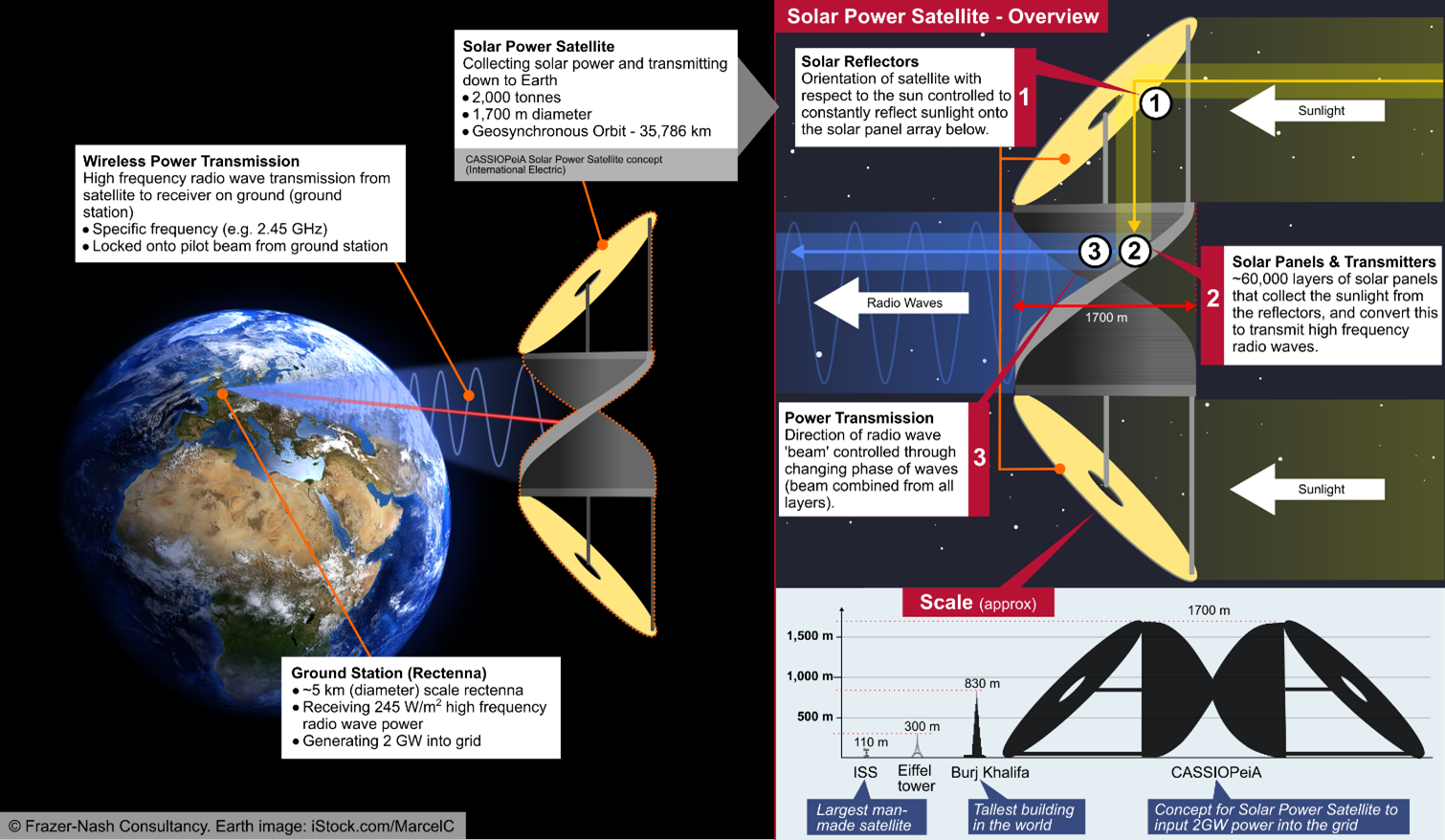In this interview, we speak to David Homfray of Satellite Applications Catapult about space-based solar power, an astronomical technology that could one day revolutionize the global energy system. Here, we discuss how looking to the skies for power could help to protect our Earth and enable us to invest in our planet.
Please could you introduce yourself and tell us about your role in Satellite Applications Catapult?
I am the Space Energy Lead at the Satellite Applications Catapult and the Technical and Programmatic Lead for the Space Energy Initiative, a collaboration of over 50 Energy and Space organizations, academia and research agencies, promoting the development of SBSP for the UK.
I have worked on some amazing science and engineering projects throughout my career, firstly working in functional brain imaging at the University of Oxford. Then, at the UK Atomic Energy Authority working on fusion research and energy applications.
I was privileged enough to be an Engineer-In-Charge of the Joint European Torus (or JET, currently the world’s largest operating fusion machine). I also helped develop the Spherical Tokamak for Energy Production (STEP) programme, the UK's brilliant and ambitious attempt to commercialize fusion.
I moved to the Catapult to work on my other passion, which is everything to do with space. I chose the Catapult because I love its ethos of supporting UK PLC and academia to grow into these amazing sectors.
How did you begin your involvement with space-based solar power?
I have spent the majority of my adulthood thinking about our need for energy and I was so focused on fusion that solar-based space power (SBSP) passed me by a bit - it then seemed quite impossible to achieve.
One of the reasons for moving to the space sector is that I knew launch costs were reducing significantly, enabling us to dream of more substantial spacecraft and missions. . When I arrived at Catapult, I immersed myself in every aspect of space-based solar power and the more I researched it, the more I saw the missing piece of the jigsaw that completed the low carbon energy puzzle, something that was technically and economically viable.
Frazer-Nash, the Satellite Applications Catapult and other organizations were setting up the Space Energy Initiative (SEI). With my background in starting large and difficult technical programmes, everything just clicked into place!

©Vadim Sadovski/Shutterstock.com
What projects are you currently involved with at Catapult?
I work in two main areas in Space Energy. I have already mentioned SBSP, but the other is nuclear in space. Now that launch costs have been reduced, our next big issue is the lack of power in space.
In this environment, if you want to move somewhere quickly, you have two choices. You either throw lots of propellant out of the back of your spacecraft, resulting in your spacecraft becoming just a massive propellant tank unable to carry any useful payload. Or, you throw less propellant at really high velocities.
To do that, you need to break the relationship between the propellant and the power, which means an external power supply that is both high power and high specific power (kilo-watts per kilogram or kW/kg).
Nuclear is the only viable option. In my opinion, the UK is really well placed to become the supplier of the world's space power supplies.
For Net-Zero, we will need a sixfold increase in our consumption of natural resources such as lithium, copper, nickel, and rare earth elements.
We will need to start to think about getting resources from our nearest neighbors (there are some lovely M-type asteroids which we could move into a nicer orbit and sort out a lot of our resource issues for years to come) and this moving of stuff and the processing of the extracted resources takes energy. If we create bases on the Moon, it is also highly likely to need a reactor.
Space-based solar power is not a new concept, with multiple organizations involved in developing this technology. What distinguishes Satellite Applications Catapult from other institutions?
I am proud that the Satellite Applications Catapult helped to set up the SEI. The SEI distinguishes itself because it understands its power is in its members.
Space-Based Solar Power is too big for one company or organization to own.
In my opinion, the SEI is the spearhead for the coalition, representing the UK on SBSP, and that is what distinguishes it from other nations.
Because of this, and the fact we are thinking about the holistic development programme rather than just a single element of the design, I think that the UK can be the first to have an operational system.
One of the COP26 outcomes primarily revolves around transitioning away from traditional fuel sources such as coal. Typically, we would think that Earth-based renewable energy like wind and tidal are the first choice. Should this be space-based solar power instead?
By 2050 there will be 9-10 billion people on this planet.
Currently, 7 billion and 2 billion of those have no access to electricity. Therefore, we need to find electricity for at least another 4 billion people. This is exacerbated as we probably need to electrify all of our common devices, from vehicles to heating.
All of this means we are going to need to either add or replace 40 billion MWhr by 2050. There is a little over 10,000 days to 2050, and to reach this, we have to add or replace 4 million MWhr per day. For context, that would mean if you just went the fission-only route, you would need to build one Hinkley Point C per week, every week till 2050.
There is no silver bullet to save our species. We need to incentivize energy efficiency, and invest and accelerate low carbon technologies such as the build of renewables energy storage and new big fission power plants.
We must invest in fusion, small modular reactors, microreactors to replace diesel generators and Space-Based Solar Power. The innovative programs behind these developments can also help to create jobs, spinout technologies, and generate economic and socio-economic growth.
How space-based solar power can save the planet | FT
How space-based solar power can save the planet | FT. © Financial Times/YouTube.com
Space-based energy sources are considered a prominent player in the path to net-zero. Why is it important to invest in innovative technologies to help mitigate the ongoing climate crisis?
Firstly, we need investment to tweak the economy slightly and help businesses see the commercial merit of moving across to the Net-Zero economy.
Investing in large programs that support this effort can create more jobs in the sector and involve the general public along the journey. These programs will also have spill overs and spinout opportunities, creating new sustainable products and technologies that can benefit society.
Many mid to low-income countries remain reliant upon fossil fuel energy sources, often due to a lack of renewable energy infrastructure. How might space-based solar power avoid this problem?
This is the real beauty of space-based solar power; it is completely dispatchable. We can switch between terrestrial and space-based power depending on whether sufficient energy is supported by decent wind and weather conditions.
Space-based solar could help some countries leapfrog over their reliance on fossils in numerous ways. With support from governmental organizations, it is the best technology alongside terrestrial renewables to support this transition in my opinion.
Could you describe in more detail how these technologies might work and how they could be constructed?
Essentially, it would be a huge spacecraft in orbit and would use mirrors to reflect sunlight onto photovoltaics, which would be converted into microwave beams to a receiver on Earth. We are currently favoring geostationary orbit, but there are some other interesting orbits that might also have value.
There is thirteen times more solar energy in space than the UK's average, and of course, it is constant. For context, there is a hundred times more solar than the 2050 forecasted global energy demand in a narrow strip in geostationary orbit.
The spacecraft would be the largest structure we have ever built in space, but it is light and a reduction in launch costs has meant that space hardware is significantly more accessible.
We are going to design mass-produced modules that plug together like Lego, making the craft easy to assemble and reproducible. From studies, we predict that once the program is complete, we can make one of these for about £4 billion; for context, Hinkley Point C is more than £20 billion for similar power levels.

© David Homfray/Space Applications Catapult
Are there any challenges that are limiting the development of space-based power? How might they be overcome?
Over the last year, support for space-based solar power has grown, with international interest from Japan, the US, Australia, South Korea and China. The UK Government has released a significant report, "Space based solar power: de-risking the pathway to net zero", showing the technical and economic viability of SBSP. This report also added SBSP to the national space strategy.
The main limitations to this project are funding and international cooperation to standardize some of the receivers. The frequencies and operational orbits for the satellite also require confirmation.
What aspect of this technology and your involvement with its development do you personally find the most exciting?
There are many exciting technologies, such as the components that make up the system itself, the power beaming and the assembly space robots we may need. For me, however, the most exciting challenge is the scale.
The way systems are developed has changed over the years – it is about design, simulation, quick build, test, fail fast, learn and repeat.
Industries have been preparing for this next revolution for the last decade, and now we are going to take all of these lessons and build something that has never been built. We will have to do it fast and make it economically attractive, and we are going to grow the economy while we are doing it. I find this the most exciting.
Where can readers find more information and stay up to date with space power developments from Space Applications Catapult?
About David Homfray

David Homfray has worked in various innovation, research and future thinking roles for over two decades. He has contributed to cutting edge research and the maturation of the resulting technologies within neuroscience and functional brain imaging (at the University of Oxford), nuclear innovation (the majority being fusion research at the United Kingdom Atomic Energy Authority) and upstream and downstream space technologies (at the Satellite Application Catapult).
He is both a Chartered Physicist, Chartered Engineer and a Fellow of the Institute of Physics, Royal Astronomical Society and the British Interplanetary Society. Currently, David is the Space Energy Lead for the Satellite Applications Catapult supporting the development of high energy density power, the surrounding subsystems and their potential applications for space and also the Technical and Programmatic Lead for the Space Energy Initiative (SEI), a consortium of over 50 organizations (academia, public, catapults, primes and SME's) that are promoting the development and delivery of Space-Based Solar Power.
Disclaimer: The views expressed here are those of the interviewee and do not necessarily represent the views of AZoM.com Limited (T/A) AZoNetwork, the owner and operator of this website. This disclaimer forms part of the Terms and Conditions of use of this website.